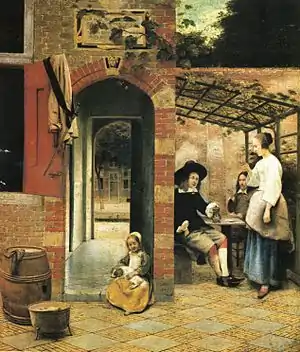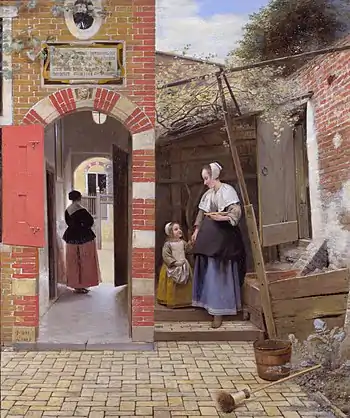The Courtyard of a House in Delft
The Courtyard of a House in Delft is a 1658 oil painting by Pieter de Hooch, an example of Dutch Golden Age painting. The painting portrays domestic architecture typical of de Hooch's middle period, with building and courtyard dominating people. It is signed and dated to the left on the archway "P.D.H. / A 1658".

| The Courtyard of a House in Delft | |
|---|---|
 | |
| Artist | Pieter de Hooch |
| Year | 1658 |
| Medium | Oil on canvas |
| Dimensions | 73.5 cm × 60 cm (28.9 in × 24 in) |
| Location | Collection of the National Gallery, London, London |
The scene is divided into two pieces. To the left, an archway of brick and stone leads from a paved courtyard a passageway though a house, where a woman dressed in black and red stands looking away to the street beyond. A stone tablet above the doorway was originally over the entrance of the Hieronymusdale Cloister in Delft. It reads, in Dutch: "Dit is in sint hieronimus daelle / wildt v tot pacientie en lydtsaemheijt begeeven / vvand wij muetten eerst daellen / willen wy worden verheeven 1614" (in English: "This is in Saint Jerome's dale / please be patient and meek / for we must first descend / if we wish to be raised."). When the cloister was suppressed this tablet was removed but can still be seen set into the wall of a garden behind the canal.
To the right is a vine growing over a wooden structure, with an open door through the brick wall to the far right, and a woman dressed in white and blue leading a child down steps to the courtyard. The woman is carrying a dish in her other hand, and a bucket and a broom have been left in the courtyard.
Similar figures can also be seen in contemporaneous works including A Woman Drinking with Two Men (1658), and the woman in black and red can be seen in A Boy Bringing Bread (1663). A similar composition with the same doorway can be seen in the Courtyard with an Arbour, also dated 1658, which sold at Christie's in London in December 1992 for £4.4 million.[1]
There are some subtle effects that are at variance with the overall impression of harmony. The brickwork of the wall on the right is dilapidated compared to the house on the left; there is an interesting double perspective that differentiates the two halves that are divided by the right edge of the archway and building above. Nature is making incursions to the well swept courtyard from the plant border on the right, including the shrub above the couple's head, and the vine obscuring the stone tablet.
The painting was documented by Hofstede de Groot in 1908, and catalogued by John Smith (Sm. Suppl. 50) and de Groot (de G. 38).[2]
It remained in the Netherlands until 1825, when it was bought by Sir Robert Peel. It was engraved by Paul Adolphe Rajon. It was sold in 1871 by Peel's son Sir Robert Peel, 3rd Baronet, along with the rest of his father's art collection, to the National Gallery, London, where it was No. 835 in the 1906 catalogue.[3]
The work was the subject of a poem by Derek Mahon.[4]
References
- Sale record for The Courtyard of a House in Delft with a young Woman and two Men drinking and smoking under an Arbour and a Girl with a Dog on her Lap sitting in a Doorway, a street with a canal beyond at Christie's, lot 104, sale 4915, on 11 December 1992 in London
- Comparative table of catalog entries between John Smith's first Catalogue raisonné of Hooch and Hofstede de Groot's first list of Hooch paintings published in Oud Holland
- entry 291 for View into the Courtyard of the Former Cloister of Hieronymusdale, in Delft in Hofstede de Groot, 1908
- Courtyards in Delft, 1981. Gallery Press. Detailed in Brown, Terence. The Literature of Ireland: Culture and Criticism, Cambridge University Press, 2010. ISBN 978-0-521-13652-5
External links
- Pieter de Hooch, The Courtyard of a House in Delft, National Gallery
